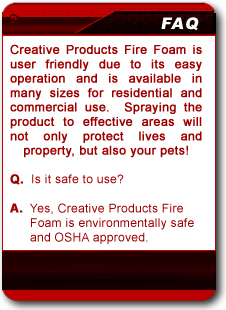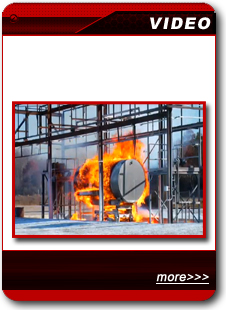The "Cause" of Fire
At Risk At Home: Living Safely in Your Apartment
Because families in apartment complexes live so close together, there are special areas of concern when it comes to fire safety. Apartment complexes are simply a series of small, connected homes. It's important to remember that what you do in your apartment can affect people living six doors down, or even in the next building.
Special Hazards That Affect People Who Live In Apartments:
- Often, there is only one way in or out and no back door.
- Stairways are often built entirely of wood. If the stairwell or walkway is on fire, you may not be able to exit through the front door.
- Congested parking can mean blocked fire hydrants and/or blocked fire lanes. (A ladder truck can be 8 to 9 feet wide and 50 feet long. A blocked fire lane can slow down response time.)
- An apartment building is, in effect, a very densely populated neighborhood. (If the downstairs or next-door apartment is on fire, it can spread quickly to adjoining apartments in a matter of minutes.)
- Without properly working smoke alarms, it may take a long time before you find out that another part of the apartment building is on fire. Consequently, this could cut your chances of getting out of the building alive.
Leading Causes of Apartment Fires
There was an overall reduction in cooking-related fires over the 10-year period, with a gradual increase in these fires since 1998. While arson and suspicious climbed from 3 in 1995 to 16 in 2000. This rise could be the result of improved follow-up on the results of fire investigations to update reports rather than an actual increase in this type of fire. Heating and electrical fires fluctuated over the period, showing a decrease in 2000.
House Fires
The Most Common Disasters in the United States are home fires, yet 80 percent of Americans are unaware that their homes could be at high risk. With heating costs on the rise, alternative heating methods are becoming more common and reliable but few realize that they can often be more hazardous.
Make or buy a self-contained emergency preparedness kit, such as the Adult, 3 Day Kit available through the Red Cross.Org Online Store or at our local office, and customize it with personal items such as clothing, an extra pair of glasses, house and car keys, prescriptions and copies of important family documents. In the event of a fire or other disaster requiring evacuation, you can quickly grab it as you exit. For more information about building and personalizing a kit, please contact us! A new poll conducted by the American Red Cross found that four in 10 families (42 percent) indicate that they are using alternative heating methods such as space heaters, wood/coal stoves and fireplaces to keep warm this winter. Among families with children under the age of 18, the figure rose to 49 percent. The National Fire Protection Agency reports that children are twice as likely as adults to die in residential fires.
According to the U.S. Fire Administration, alternative heating sources play a part in 74 percent of fire-related deaths. Last year alone, the Red Cross helped families affected by nearly 67,000 house and apartment fires, providing immediate emergency assistance. Each chapter maintains a disaster relief fund specifically for dealing with local disasters. This money is most often used to provide food, clothing, temporary shelter and other special needs to affected families. Even though fire kills more Americans each year than all natural disasters combined, of those polled, two-thirds said that they thought hurricanes, tornados, floods and mudslides posed a greater threat to their homes than fires. "Although many residential fires are preventable, fires can ignite quickly and without warning," said Heidi Taylor, fire safety expert at the American Red Cross. "It is important that every family plan ahead and practice their escape for residential fires, don’t wait until they happen."
Losing a home to a fire is a traumatic experience for any family, but there are steps you can take all year long to minimize the threat. The Red Cross urges Americans to prepare their families for the unexpected. Develop a family disaster plan and take these steps toward fire prevention and safety: Simple Steps to Prevent Fires “Keep all sources of fuel (paper, clothing, bedding and carpet/rugs) at least three feet away from all heat sources.” Always make sure children have full adult supervision while cooking or Iighting rooms with candles or fires. Never leave burning candles unattended. “Keep matches and lighters out of the reach of children.” Teach young children to notify an adult when they see matches and lighters and encourage them not to play with fire if curious or bored. Simple Steps to Make Your Home Safer "Install a smoke alarm inside and outside each sleeping area in your house and on each additional level. Test smoke alarms regularly (once a month) and replace batteries immediately. Smoke alarms become less sensitive over time and should be replaced every 10 years. "Consider having one or more fire extinguishers in your house and know how to properly operate them. Training can be obtained from your local fire department.
"Consider installing an automatic fire sprinkler system in your home." Know and learn two different ways to escape from every room of your home. Determine if you need escape ladders for sleeping area on the second or third floor. Learn how to use them and keep them near a window. "Select a location outside your home as a meeting point for your family to gather after evacuating the house. Practice your escape plan twice a year, especially with children. Safety Tips in the Event that Fire Strikes Your Home… "Once you are out of your home, stay out! Use a neighbor’s phone to call the fire department. "If you see smoke or fire in your escape route, use your second way out. If you have to get through smoke, stay low and crawl toward the exit. If exiting through a closed door, be sure to feel the door prior to opening it. If it is warm or hot, use your second way out. “If smoke, heat, or flames block your exit routes, stay in the room with the door closed. Signal for help by tying a brightly-colored cloth at the window. Call the fire department to tell them your location if there is a phone in the room.
Electrical Fires
The most common cause of electrical fires is directly related to wiring and connection faults. The word “short” needs to be qualified, as it is often misunderstood. Short circuits are relatively uncommon and in most cases it is because a positive and a negative cable have been inadvertently connected. This is called a “dead short circuit” and usually blows the fuse or trips the circuit breaker immediately. The other type of short has resistance involved between the positive and the negative or ground during a short circuit event.
Hotel Fires
Hotels consist of various areas, related to fire detection and suppression systems.
MGM GRAND HOTEL
- Meeting Rooms
- Ball rooms
- Casinos
- Offices
- Shops
- Kitchens
- Laundries
- Fitness centers
- Saunas
- Garages
- Stock rooms
- Boiler rooms
- Electrical centers
- Complex air handling systems
- High rise hotels (worst case)
- Wooden buildings
As you see, there are very different types of places with in hotels. Fire safety of each place must be planned individually and carefully.
Commercial Boat Fires
A report has been released based on a study by Boat US and published in Seaworthy Magazine, which is the only damage avoidance magazine for boat owners and the marine insurance industry in the USA. The causes of boat fires originating on board boats are summarized as follows and are bases on fire related insurance claims:
- 55% AC and DC wiring and appliances
- 24% Engine and transmission overheating
- 8% Fuel leaks
- 7% Miscellaneous
- 5% Unknown
- 1% Stoves
Commercial Fishing Boat Fires
Every major port has a fleet of these important workhouses of the sea bringing your lobster or scallops for dinner. These boats are out there most days catching fish. But they can catch something else. They can catch FIRE.
Small Boat and Marina Fires
Almost every area in the country will have a marina or some body of water on which pleasure craft pass. Fires on a pleasure craft, whether underwater on in a marina, will pose special challenges and hazards to the land based firefighter.
Car Fires
Every year in the UK, around 73,000 cars, which equates to 200 a day go up in flames and around 100 people die as a result. 65% of these fires are started deliberately to cover criminal activity, to make a fraudulent insurance claim or as an act of vandalism. One in 12 reported stolen vehicle would be burnt out. Many other vehicle fires break out simply due to a lack of basic maintenance and can be prevented.
The financial loss of having a car fire is bad enough and, although insurance may compensate for this, nothing can help with the shock and inconvenience that follow even a small fire:
- Last year, there were an estimated 266,500 vehicle fires in the U.S. involving passenger cars, SUV’s and small trucks.
- These accidents killed an estimated 520 people, injured 1,300 and caused $1.3 Billion in direct property damage, according to the National Fire Protection ASSN., a Nonprofit Research and Education Organization dedicated to reducing fire hazards. In California alone there were 7,764 vehicle fires, according to California State Fire Marshal data.
- "In 2004, highway vehicle fires in the U.S. caused more deaths than apartment fires", said James M. Shannon, President of the Fire Protection Association. “The public needs to be more aware of this serious fire safety issue and take measures to lessen the risk of an incident.”
- According to the NFPA, cars catch fire on American highways once every two minutes.
- The risk of a car or vehicle fire is even greater than the risk of an apartment fire.
- "More people die in vehicle fires than in apartment fires each year in the United States," said AAA President Robert Darblenet.
Fire Hazards on Airplanes
Fires aboard airline flights are more common than you think. More than 1,000 smoke or fire incidents on airline flights were reported.
The confusion and lack of training about how to deal with fires on airplanes in flight, to say nothing of the existence of flammable materials on airplanes, are serious threats to passenger safety.
One of the worst air disasters involving fire, Swissair Flight 111, which crashed off the coast of Nova Scotia killing all 229 people aboard, occurred because of a fire that ignited above the ceiling panels on the plane.
What Causes Forest Fires
There are five main causes to forest fires that should be acknowledged. These five causes include the following:
1. Natural Fires
2. Accidental Fires
3. Fires due to negligence
4. Fires due to arson
5. Fires of dubious cause



